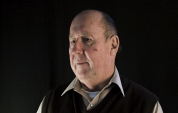7:42 | Helicopter pilot Tony Coalson felt lucky when he was placed in the 201st Aviation Company instead of being thrown into the replacement circuit. He was sent to Vietnam on a troop ship, a practice that was soon to be abandoned. The trip was uncomfortable, but very interesting.
Keywords : Tony Coalson Vietnam helicopter pilot replacement 90th Replacement Battalion Khe Sanh 201st Aviation Company USS General William Weigal (AP-119) troop ship Golden Gate Bridge seasick man overboard Philippines Shore Patrol (SP)

He'd gotten his private pilot's license through Army ROTC, but it was in helicopters that they wanted Tony Coalson to be trained. He wasn't real excited about that until he got in one. It was in training that a grim sense of humor began to form among the close knit pilots.
In flight school, every day was a new day, always a new procedure to learn. Helicopter pilot Tony Coalson remembers learning slope landings and connects that to the first time he actually used one in a combat situation. It was during the Tet Offensive, on the lawn of a beautiful resort hotel built by the French.
The anxiety increased as the troop ship approached Vietnam. Once ashore, Tony Coalson was sure they would be ambushed at any minute. In reality, they were in a very safe part of the country. As the aviation company settled into their base at Nha Trang, they had no idea that they had drawn one of the best assignments they could get.
Tony Coalson's helicopter unit flew all of II Corps, a fourth of the entire country, unlike dedicated combat units, which only flew in their little slice of Vietnam. He recalls his first combat related mission, in which he delivered an assessment team right in the middle of one of the biggest battles of the war. Part 1 of 2.
When helicopter pilot Tony Coalson was on the ground during the Battle of Dak To, he was astounded at the numbers of American dead. Some of the casualties were from a terrible friendly fire incident. He remembers watching a C-130 full of wounded men just barely survive takeoff. When he returned to his base, he had a solemn observation for his roommate. Part 2 of 2.
The 201st Aviation Company had a wide variety of missions in Vietnam. Pilot Tony Coalson describes a particularly stressful flight to pick up a special forces team which had been overrun. He knew it was going to be dangerous when he saw the number of gunships that had been assembled. Part 1 of 2.
The helicopter came in fast, touched down for a moment, and the besieged special forces team ran for it. Pilot Tony Coalson remembers seeing a huge amount of enemy bodies in the concertina wire. On the way back, he asked them, what happened back there. "It was Custer's last stand." Part 2 of 2.
The Tet Offensive was the most singular event of the Vietnam War. For helicopter pilot Tony Coalson, it began as almost nothing, but he knew it was a big deal when they brought out the 50 cal machine gun at the base. Does anybody here know how to use this thing? Part 1 0f 3.
The men were sitting on a bunker, watching and listening to the chaos of Tet unfold around them. They were an aviation company in a rear area, but each man was issued a grenade, which caused quite a bit of reflection because they were not at all used to ground combat. Then, pilot Tony Coalson dropped his. Part 2 of 3.
It was an unlikely duel. A lone North Vietnamese with an AK-47 firing at an F-4 fighter jet coming around for pass after pass. Tony Coalson remembers watching that unfold at 3 AM, the first night of the Tet Offensive. What the news media did with the news of this widespread surprise attack altered the perception of the war back home. Part 3 of 3.
The Tet Offensive was only the introduction to Vietnam for helicopter pilot Tony Coalson. He still had eight months to go, but after that huge operation, it was much more routine. One thing he noticed was that the enemy persisted, even after massive amounts of American firepower was used.
Your year in Vietnam went by fast, if you made it through, says Tony Coalson. He did get one R&R in Hong Kong but the night before he was going to leave, something came up. It was another problem for which the solution was his helicopter.
Relatively speaking, Tony Coalson's aviation unit had good living conditions in Vietnam. He describes the ones that were worse and then moves on to the ones that were better. Way better.
It was a tremendous relief when his year was up and he came home. Helicopter pilot Tony Coalson still had six months to go on his commitment, so he became one of the men who could tell trainees, this is how it really is over there. He had not planned to return to Vietnam, but it happened with Air America.
His Army experience was very valuable to him, but it was with Air America that Tony Coalson came to understand what was really happening in Vietnam.